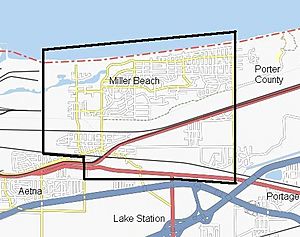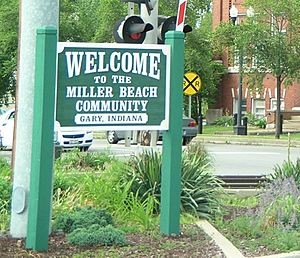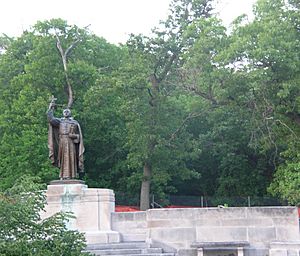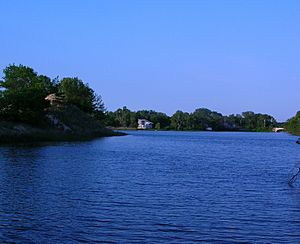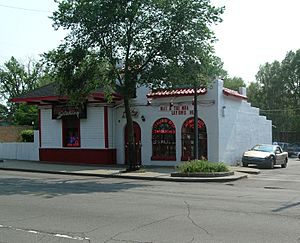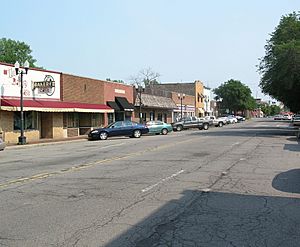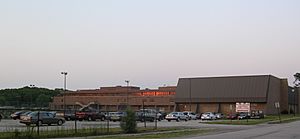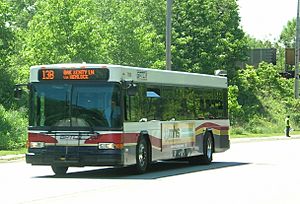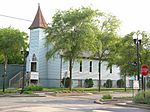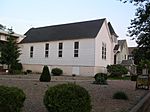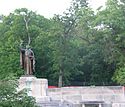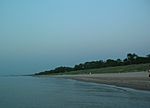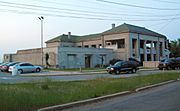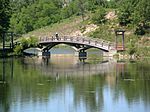Miller Beach facts for kids
Quick facts for kids
Miller Beach
|
|
|---|---|
|
Neighborhood
|
|
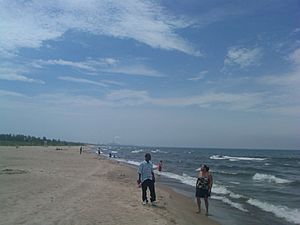
The Lake Street Beach in Northwestern Miller Beach
|
|
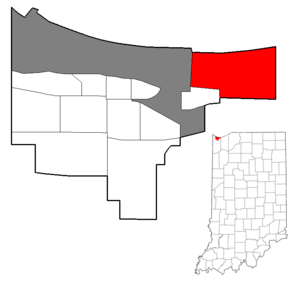
Location within the city of Gary
|
|
| Country | |
| State | |
| County | Lake County |
| City | Gary |
| First settled | 1851 |
| Incorporated | 1907 |
| Annexed by Gary | 1918 |
| Area | |
| • Land | 15.17 km2 (5.86 sq mi) |
| • Water | 4.45 km2 (1.72 sq mi) |
| Population
(2000)
|
|
| • Total | 9,900 |
| Demonym(s) | Millerite |
| Time zone | UTC-6 (CST) |
| • Summer (DST) | UTC-5 (CDT) |
| ZIP code |
46403
|
| Area code(s) | 219 |
Miller Beach, also called Miller, is a neighborhood in Gary, Indiana. It sits on the southern shore of Lake Michigan. People first settled here in 1851. Miller Beach was once its own town. But in 1918, it became part of the city of Gary.
This area is in the northeast part of Lake County, Indiana. It is now known as "The Miller Beach Community." Miller Beach is next to Lake Michigan on the north. It borders Porter County to the east. Much of the land around it is protected. This includes parts of Indiana Dunes National Park. Miller Beach is also the closest beach area to Chicago. It has been a popular vacation spot for over 100 years. In 2000, about 9,900 people lived here.
Miller Beach has many protected lands. These lands are home to rare ecosystems. It includes the western part of Indiana Dunes National Park. This park is part of the U.S. National Park system. It covers areas like Miller Woods and Long Lake. The West Beach area of Indiana Dunes is just east of Miller Beach. All of Miller's shoreline is a public beach. Marquette Park is a large park by the lake. It is a national landmark. It has old buildings, sculptures, and was a site for early flight tests.
Miller Beach is less than an hour from downtown Chicago by car. This has made it a popular place for Chicagoans to visit and live. It is the wealthiest area in Gary. Miller Beach has several business areas. This includes the Miller Beach Arts and Creative District. It also has many public and charter schools. The community is close to exits for four major interstate highways. It also has South Shore Line commuter trains. Miller Beach is known for its mix of people and nature. It has been called "an island of integration and natural beauty."
Contents
Exploring Miller Beach's Location
Miller Beach is at the southern tip of Lake Michigan. It is also at the northeast tip of Lake County. Most of Gary's lakefront has heavy industries. Miller Beach is the only living area in Gary with a natural lakefront. The shoreline of Miller is owned by the public. Beachfront homes are separated from the lake by sand dunes.
Protected lands surround Miller Beach. The only nearby neighborhood is Aetna to the southwest. To the west, the Miller Woods area of Indiana Dunes National Park is between Miller and U.S. Steel's Gary Works. To the east, Miller borders the Park's West Beach area. To the southeast and south, the Little Calumet River separates Miller from Portage and Lake Station.
A strip of National Park land divides Miller's northern and southern parts. This makes the northern half of Miller Beach fully surrounded by the National Park.
Neighborhoods Within Miller Beach
Miller Beach has grown over time. Because of this, it has several different neighborhoods. The oldest part is The Grandlake Historic District. It is between Lake Street and Grand Boulevard. This area has Miller's oldest homes and buildings. Some were built when Miller was an independent town. Examples include Miller Town Hall and Miller School.
The northern part of Miller Beach is mostly homes. It is completely surrounded by national parkland. In the far northeast, along County Line Road, is East Edge. This is Miller's most expensive area. Next to it is the Miller Village apartment complex.
West of downtown Miller is Duneland Village. This is another apartment complex. It has a small baseball park called Gibson Fields. This field has been home to Miller Little League for many years. To the east, more than a mile from downtown, is Inland Manor. This area is in the middle of Indiana Dunes National Park. The U.S. government has bought all property in Inland Manor. Many residents still live in their homes under special agreements.
Miller Beach's Past
Early History of the Area
When Europeans first came to Lake Michigan in the 1600s, the Miami people lived here. By 1640, the Miami had left the area. The Potawatomi then moved in from the north. The Potawatomi often came to the Indiana Dunes area. They hunted, fished, and gathered food like wild rice. The Odawa people also hunted deer here in winter.
French missionary Father Jacques Marquette traveled along Lake Michigan's south shore in 1675. He was trying to return to Canada. He had become very sick. Local stories say Marquette camped near the Grand Calumet River in what is now Marquette Park. This was shortly before he died.
As the United States grew west, the Potawatomi were moved from Indiana. This happened through treaties and forced removals in the 1820s and 1830s. Indian Boundary Road in Miller Beach marks a border from one such treaty in 1826. By 1836, the Potawatomi had lost all their lands in Indiana. However, some Potawatomi stayed in Miller Beach as landowners. This included Simon Pokagon, a chief of the Pokagon Band. Other Potawatomi visited the area in spring and summer until the late 1800s.
In the 1800s, many people wanted to build towns in the Calumet Region. But the land was difficult, and there was no easy transport. In 1833, an inn called Bennett Tavern was built. It served stagecoaches traveling between Detroit and Chicago. It only lasted a few years. The first person to plan a town in Miller Beach was Joseph Bailly. In 1833, he planned a "Town of Bailly." It was at the mouth of the Grand Calumet River. But this town, and "Indiana City" planned nearby in 1837, did not develop.
In 1837, the area that became downtown Miller was bought and planned. This was done by William and George Ewing and George H. Walker. The plan was called "Ewing's Subdivision." Development here started when the railroad arrived in 1851.
The Town of Miller
The Lake Shore and Michigan Southern Railway arrived in 1851. A train stop was set up in downtown Miller Beach. It was first called "Miller's Station." Later, it was "Miller's Junction" or "Miller's," and then "Miller." The town was named after someone, but it is not fully known who. One story says it was a construction engineer named John Miller. Early trains would stop at his home for water and wood.
Many Swedish immigrants came to Miller in the 1860s. They were escaping famines in Scandinavia. Early Miller residents, both Swedish and German, worked in sand mining, ice harvesting, and railroad maintenance. Miller was very small then. Only twelve families lived there in 1870. Miller got its first schoolhouse in the 1860s. Its own post office opened in 1879. In the 1880s, the town had a small fishing business. Fishermen caught sturgeon and whitefish. Some sturgeon weighed up to 200 pounds.
Miller's location near Chicago and its beautiful nature soon drew visitors. Octave Chanute, a flight pioneer, did experiments here in 1896. He flew from the 70-foot dunes near Lake Street Beach. Around the same time, botanist Henry Chandler Cowles studied how nature changes in Miller Woods. Later, the Chicago film industry used Miller's dunes and beaches. They filmed many silent films here. These films were set in exotic places.
In 1907, Miller residents decided to make their community an official town. They hoped to avoid being taken over by Gary. Gary was a new and growing city. Gary's mayor tried to annex Miller in 1910. At that time, Miller had 638 people. Miller successfully fought off this first attempt.
In the 1910s, Gary and US Steel wanted a lakefront park for workers. So, Miller and Gary created a joint parks department in 1915. They managed part of the land that is now Marquette Park. But Gary had trouble buying this land. So, Gary wanted to annex Miller. This would allow Gary to take the land for public use. In 1918, Miller's town board agreed to be annexed. This ended Miller's independence.
Becoming Part of Gary
After Miller became part of Gary, it kept growing. Its tourism also grew. Drusilla Carr owned Carr's Beach (now Lake Street Beach). She rented out over a hundred beach cottages. Carr's Beach was Gary's most popular summer spot in the late 1920s. It had a shooting gallery, bath house, and miniature railroad.
Marquette Park was built and expanded in the 1930s. More wealthy people moved to Miller in the late 1940s. The neighborhood became more of a resort area. In 1967, Richard Hatcher became Gary's mayor. He was the first African-American mayor of a major U.S. city.
In 1971, local residents formed the Miller Citizens Corporation (MCC). They wanted to help the community stay stable. The MCC worked to keep people from leaving the community. They promoted Miller's good points. They also banned "For Sale" signs. The group also worked on environmental issues. This included stopping sand mining in living areas.
Indiana Dunes National Park was created in 1966. But it did not include Miller Woods and Long Lake at first. After Senator Paul Douglas died in 1976, a bill passed to expand the park. It was a memorial to him. The park grew by 4,300 acres. This included Miller Woods and Long Lake.
In 2002, Gary faced money problems. The city almost doubled tax rates. This caused many complaints. The Miller Citizens Corporation and other groups asked the state to limit taxes. Tax limits became law in 2008. They became part of the state constitution in 2010.
Who Lives in Miller Beach?

Miller Beach started as a working-class town. Most people were Swedish-American and German-American. The neighborhood became wealthier and more diverse in the late 1940s. In 1950, Miller became Gary's wealthiest area. It has stayed that way ever since. Miller grew by 70% in the 1950s. During this time, many Jewish people moved to Miller Beach.
The first house in Miller Beach bought by an African-American family was in 1964. Miller Beach changed in a stable way through the 1970s. It became a mixed community. Many new African-American residents were professionals. Miller Beach was one of the only areas in Gary to grow in population during the 1970s.
Many people have moved to Miller Beach from Chicago. They look for a break from city life. One early example was Alice Mabel Gray. She was known as "Diana of the Dunes." She spent time in Miller Beach in the early 1900s. In the 1950s, author Nelson Algren bought a house here. He used money from his Pulitzer Prize. Another wave of people moved from Chicago in the 1990s. Miller Beach's accepting style has also attracted many gay and lesbian families.
Nature in Miller Beach
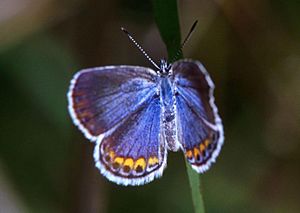
Miller Beach has "some of the most natural habitats" in Northwest Indiana. The freshwater panne habitat is found in Miller Woods and West Beach. It is considered very rare by the Nature Conservancy. The dune and swale complex is special to the southern Great Lakes. Only a few small areas of it remain. Sand oak savanna is also rare. Miller Woods has one of the best examples of it.
This mix of dunes and wetlands comes from changes in Lake Michigan and the Grand Calumet River. These changes happened since the last ice age. The glaciers melted about 18,000 years ago. This formed Glacial Lake Chicago. Some cold-weather plants and animals stayed here. Later, warmer-weather species moved in. These included the six-lined racerunner and prickly pear cactus.
After the glaciers, the lake levels changed many times. Each change left marks on the land. The Tolleston Beach dunes were formed during the Algonquin stage. These are in the southern part of Miller Beach. The later Nipissing stage created the high dunes. These are in the northern part of Miller Beach. Around 2600 years ago, the Grand Calumet River formed. Before the 1800s, it flowed into Lake Michigan at Marquette Park. The Grand Calumet Lagoons are there today. The river's direction was changed in 1862. But because the river is almost flat, its flow can reverse after heavy rains.
Plants and Animals of Miller Beach
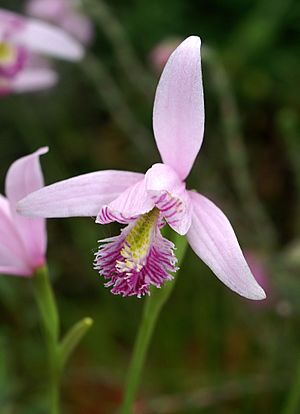
Indiana Dunes National Park has many different kinds of plants and animals. It includes large areas in and around Miller Beach. Miller Woods alone has 287 species of plants and animals. This includes the endangered Karner Blue butterfly. It also has the threatened Pitcher's thistle.
The park has 1,445 plant species. This is more species per area than any other national park in the U.S. Many types of orchids grow in Miller Woods. These include the Northern fringed orchid and snake-mouth orchid. Some plants, like the fame flower, only grow in Miller Woods within the Indiana Dunes.
Many wild mammals live in Miller Beach's natural areas. These include the Virginia opossum, prairie deer mouse, fox squirrel, and beaver. The coyote returned in the 1990s. It is the largest wild predator here. The white-tailed deer is the largest plant-eater. Several types of bats are thought to live here. This includes the endangered Indiana myotis.

Miller Beach and West Beach are important stops for many migratory birds. This is because they are at the southern tip of Lake Michigan. The Audubon Society has named these areas Important Bird Areas. The beachfront is known as a great place to see jaegers in autumn. It is also a spring flyway for the sandhill crane. Rare birds like the least bittern and Virginia rail stop at Long Lake.
Miller Woods has 18 types of reptiles and amphibians. This makes it one of the most diverse areas for these animals in the Indiana Dunes. These include the Fowler's toad, the six-lined racerunner, and the endangered Blanding's turtle. The slender glass lizard lives in the Inland Marsh area.
Community Life in Miller Beach
"Where else could you catch salmon or trout in the morning, be in easy access to your metropolitan office, attend a major league game in the afternoon, and still enjoy a dinner with the family in a home near the big water or nestled in the wooded dunes?"
The Miller Citizens Corporation (MCC) has been important in Miller Beach since 1971. It was started to help the community stay stable during changes in the 1970s. The MCC quickly started working on other things. This included protecting the environment and planning how land is used. In recent years, the MCC has also worked on city fees and taxes.
Other important groups in the neighborhood include the Humane Society of Northwest Indiana and Crisis Center. The Crisis Center has been in Miller Beach since 1988. It helps teens and adults with crisis intervention and suicide prevention.
Miller Beach has had active religious groups since 1874. The Swedish-speaking Bethel Lutheran church started then. It first met in the Miller schoolhouse. The town's first English-speaking church, Chapel of the Dunes, was built in 1901. Both of these early churches are still standing today. The Roman Catholic parish of St. Mary of the Lake started in 1929. Miller Beach also has Gary's only working synagogue, Temple Israel. It is a Reform congregation founded in 1910.
The Miller Garden Club started in 2000. It holds an annual garden walk and plant sale. Miller also has several community gardens. One is a joint project between Miller's Lutheran and Jewish groups.
Many festivals happen in Miller each year. This includes the South Shore Air Show at Marquette Park. The biweekly farmer's market is also a community fair. Groups like the Miller Historical Society have information booths there. In 2011, Miller hosted the only gay pride parade in Northwest Indiana. This annual parade has been held in Gary since 2006.
Miller Beach is part of the First District of the Gary Common Council. Residents also vote for three council members who represent the whole city.
Miller Beach's Economy
Miller Beach's economy is mostly about retail and tourism. There is no heavy industry here. Because of its wealthy residents and lakefront, Miller Beach attracts expensive housing projects. Many homeowners in Miller work in Chicago. Some have their main home in Chicago and a vacation home in Miller Beach.
Home values in Miller are the highest in Gary. In 2006, a lakefront home in Miller sold for over $1 million for the first time. In 2008, the "East Edge" area was the most expensive in the city. Single-family homes there cost over $500,000. In 2000, Miller had 4,773 housing units. About 47.4% were owned by the people living in them.
Businesses in Miller Beach are mainly along Lake Street and U.S. 20. These are in the southwest part of the neighborhood. The Lake Street area is a traditional downtown. The city calls it a "pedestrian-friendly, 'Main Street' character." This downtown area is the easiest part of Miller Beach to walk around. Most stores for residents are along this street. The historic Miller Train Station was moved a short distance. It is now the main dining room for Miller Pizza Station. This is a popular restaurant downtown.
The U.S. 20 area is another business center. It runs along Miller's southern edge. Businesses along U.S. 20 mostly serve highway travelers.
In the summer, the Miller Beach Farmers' Market offers fresh food. It started in 2008. The Miller Beach Arts and Creative District now sponsors it. The market aims to support local businesses. It also gives residents access to fresh produce and special foods.
Learning in Miller Beach
Public schools in Miller Beach are part of the Gary Community School Corporation. Public elementary schools include Marquette Elementary and Banneker Elementary. The public high school for the area is West Side Leadership Academy in Gary.
Charter School of the Dunes is a charter school in Miller Beach. It is next to Lake Street Beach. Like other charter schools in Gary, it is sponsored by Ball State University. A private religious school is run by Christ Baptist Church. The Miller Beach area also has Catholic schools from the Gary diocese.
Nearby colleges include Indiana University Northwest in Gary and Purdue University Calumet in Hammond. There are no colleges in Miller Beach itself. In 2005-2009, about 28% of Miller Beach residents had a bachelor's degree or higher.
The Paul Douglas Center for Environmental Education is in Miller Woods. It teaches residents and visitors about the environment. Many talks, classes, and workshops are held there. The trails around the center offer a self-guided nature tour.
Downtown Miller Beach has the South Shore Centre for the Arts. It is in the building that was once the Miller School. The Centre offers classes for the public. These include dance, piano, voice, and self-defense. It is also home to the South Shore Dance Alliance. This is a dance company that performs in the Chicago area.
Getting Around Miller Beach
Miller Beach is near four major interstates: 65, 80, 90, and 94. But none of them go directly through the neighborhood. Interstate 65 ends just west of Miller. Interstates 80 and 94 join as the Borman Expressway. They have exits southwest and south of Miller. The Indiana Toll Road (Interstate 90) also uses these exits. Using the Toll Road, Miller Beach is 36 miles from downtown Chicago. The trip takes about 50 minutes.
Highways that go through Miller Beach include U.S. 12. This was the earliest highway here. U.S. 20 also passes along the community's southern edge. Highways 12 and 20 connect Miller to the interstates. They also connect to downtown Gary and nearby towns. Indiana State Road 51 connects Miller Beach to towns south of the Little Calumet River.
The electric commuter trains of the NICTD South Shore Line stop at Miller Station. On weekdays, 14 eastbound and 12 westbound trains serve Miller Station. The South Shore Line has served the neighborhood since 1908.
Miller Beach is served by Route 13 buses of the Gary Public Transportation Corporation (GPTC). These buses go around the neighborhood. They end at the GPTC hub station in downtown Gary. At this station, people can transfer to buses for other parts of Gary. They can also go to towns like Hammond and Crown Point. The Metro Center also has Greyhound buses. It is the eastern end for many South Shore Line trains.
A 2.0-mile bicycle trail, the Marquette Greenway, runs through the National Lakeshore. It goes from downtown Miller Beach to West Beach. This trail is paved with fine limestone. In 2010, it was one of only two bicycle trails in Gary. The Gary Green Links plan wants more trails. These would connect Miller Beach to other towns and neighborhoods.
Famous Places in Miller Beach
Many famous places in Miller Beach are in Marquette Park. This large park covers 159.4 acres of dunes and beaches. Landscape architect Jens Jensen designed the park in the 1920s. Old buildings in Marquette Park include the Chanute Aquatorium and the Marquette Park Pavilion. Both were designed by architect George W. Maher. The park's beach, Marquette Beach, has been a popular summer spot for a long time. Because of Octave Chanute's flight tests, the park is a National Landmark of Soaring.
A bronze statue of Father Jacques Marquette stands at the park entrance. The statue was put there in 1931. This was when the park was renamed Marquette Park. Sculptor Henry Hering created the statue. It has a fancy limestone base. Work to restore the statue began in October 2010. The Marquette Park Pavilion, built in 1924, is right across from the statue.
The Pavilion is on the south bank of the East Lagoon of the Grand Calumet River. The lagoon has been carefully landscaped. In the middle of the lagoon is a small island called Patterson Island. It was built in the 1930s. The island is connected to the shore by two footbridges. One is a suspension bridge, and the other is a Japanese-style bridge.
In 2011, a $28 million project was underway to improve Marquette Park. This project started in 2009. It was the first major improvement to the park since 1931. The project covers the entire lakefront of Miller Beach. This includes the Lake Street and Wells Street beaches.
Two buildings in Miller Beach are on the National Register of Historic Places. The Miller Town Hall, built in 1911, was added in 1978. The Chanute Aquatorium was added in 1994. It is a Classical Revival building designed by George W. Maher. It was built in 1922. It was first a bathhouse. It was almost torn down in 1971. But a local group helped save it. The building was remodeled. It is now an aviation museum and event space.


